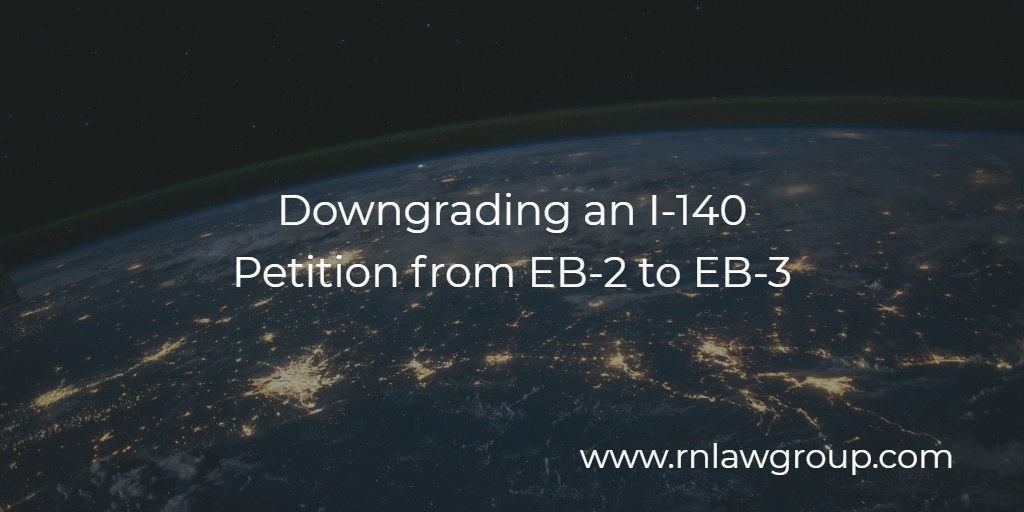
Downgrading an I-140 Petition from EB-2 to EB-3 – What is it? Why, How, and When to do it?
Every month, the Department of State’s Visa Bulletin determines immigrant visa (green card) availability for applicants waiting for employment-based adjustment of status. When a green card becomes available to an employee who has been sponsored for an employment-based green card depends on the employee’s country of birth, preference category, and priority date (date of filing the first step in the process). The two most common preference categories used for employment-based green cards are EB-2 and EB-3.
EB-2, or employment-based second preference, is available for job offers to “Members of the Professions Holding Advanced Degrees.” In other words, jobs requiring at least a Master’s degree or a combination of a Bachelor’s degree with 5 years of progressively responsible experience.
EB-3, or employment-based third preference, is available for job offers to “Skilled Workers” or “Professionals.” These refer to positions requiring at least a Bachelor’s degree or 2 years of education, training, or experience.
Twenty years ago, the majority of employment-based green card applicants were sponsored in the EB-3 category. This lead to a shorter wait for those who could qualify for the EB-2 category. As high-skilled workers gained additional education and skills over the years, since at least 2009, more workers were being sponsored in the EB-2 category than EB-3. This has created a unique situation in which EB-3 now has a shorter wait than EB-2, particular for applicants born in India or China. Many EB-2 applicants are eligible to “downgrade” to the EB-3 category in order to file their I-485 application to adjust status sooner.
A downgrade can be accomplished either by refiling a previously approved EB-2 I-140 in the EB-3 category or by filing an EB-2 intended Labor Certification in the EB-3 category.
Generally speaking, anyone with an approved EB-2 should be able to downgrade their I-140 to EB-3 because the requirements for approval under EB-2 will almost always be met for EB-3 filings, even if using a Labor Certification originally designed for EB-2 cases. Further, anyone with a Labor Certification intended for an EB-2 filing can file under EB-3, either as a professional (minimum Bachelor’s degree) or skilled worker (minimum two years of relevant education, training, or experience), so long as the original I-140 is filed during the six-month validity period of that Labor Certification. Therefore, whether you have filed and have had approved an EB-2 petition, if you have filed and have an EB-2 petition pending, or you have an approved Labor Certification yet to file your I-140, you can “downgrade” thereby bringing you closer to a current priority date.
I have an I-140 approved for EB-2. Can I downgrade? How? My Labor Certification has been expired for quite some time.
Yes, an individual with an approved EB-2 petition can “downgrade” to EB-3 using the same Labor Certification that was used for the originally filed EB-2 case. Under the Neufeld Memo released in 2007, subsequent or amended I-140 petitions can be filed at any time so long as the original approved Labor Certification was filed in support of a previously filed I-140 petition during the six-month validity period of that Labor Certification. So, as long as your original I-140 was properly filed, i.e. during the six-month validity period of the Labor Certification, you can file to downgrade to EB-3.
I have a Labor Certification pending or approved that was intended for an EB-2 case. Can I used that to file an EB-3 case? How?
Yes. Generally speaking, a Labor Certification intended for an EB-2 case can be used to file an EB-3 case. The fact that the Labor Certification was drafted or intended for an EB-2 case will not prejudice a filing in EB-3. The Government sets the minimum requirements, or “floor”, for EB-2, EB-3, etc. qualification. Conversely, the Labor Certification can be used to “raise the floor” for approval in any category. Therefore, using an EB-2 intended Labor Certification in an EB-3 petition only raises the minimum “floor” for that respective EB-3 category and doing so provides no detriment to the employer or prospective employee.
I have an approved EB-2 I-140. My friend has an approved EB-2 Labor Certification. Would we be able to downgrade for EB-3? How do we do that?
Absolutely. For those with an already approved EB-2 case, USCIS will require a subsequent I-140 be filed. You would not need to obtain a new Labor Certification. Instead, you would file this new EB-3 I-140 petition with a copy of your old, previously utilized EB-2 Labor Certification. USCIS will then process your I-140 petition as it did the original. Once the EB-3 case is approved, the individual now has I-140 approvals in EB-2 and EB-3 providing some tactical advantage as priority dates continue to move.
For those with a pending or recently approved Labor Certification, to file in EB-3, you simply choose to file the I-140 petition for EB-3 outright, rather than filing in EB-2 outright as would be typical. The adjudicative process with USCIS will be the same as if you had filed for EB-2; they take no issue with a downgrade. It’s simply a matter of meeting the bare minimum requirements. Of course, once the EB-3 is approved, an individual can choose to file another I-140 in hopes of obtaining an EB-2 priority date as well, providing additional tactical advantage as priority dates continue to move. It is also possible to file two I-140 petitions at the same time using the same labor certification, one in EB-2 and one in EB-3.
Is Premium Processing available?
It depends. For a case to be accepted for Premium Processing there is a requirement that the case be filed with an original Labor Certification. Therefore, filing in Premium Processing will be limited to those filing with an original Labor Certification filed within the six-month validity period of that Labor Certification, such as the individual filing in EB-3 category with a recently approved and valid Labor Certification. However, those filing with a copy of an expired labor certification do have the option to upgrade to Premium Processing after filing in regular processing. USCIS may reject the premium processing if the service has not yet been able to retrieve the original labor certification from the previous I-140 file. This has no negative impact on the downgrade petition itself, and the premium processing can be submitted again.
When should I downgrade?
Based on Department of State information, we anticipate that Visa Bulletin cutoff dates may advance significantly in October 2021 for EB-2 and EB-3 India. If you anticipate that your EB-2 priority date may become current in EB-3 this October, now is the perfect time to file the downgrade to avoid the rush of filings in October.
For more information on whether an I-140 downgrade is beneficial in your situation, please speak to one of our qualified attorneys at Reddy Neumann Brown PC
By: Ryan Wilck and Emily Neumann
Ryan Wilck is a Senior Associate at Reddy & Neumann, PC. and manages the immigrant visa department. Ryan began with the firm in 2012 as a law clerk and has continued with the firm as an attorney from 2014. His main practice covers immigrant visa petitions with skills and experience in various non-immigrant petitions as well as criminal issues.
Emily Neumann is Managing Partner at Reddy Neumann Brown PC with 15 years of experience practicing US immigration law providing services to U.S. businesses and multinational corporations. Emily has been quoted in Bloomberg Law, U.S. News & World Report, Inside Higher Ed, and The Times of India on various hot topics in immigration. She is a member of the American Immigration Lawyers Association and Society for Human Resource Management.


